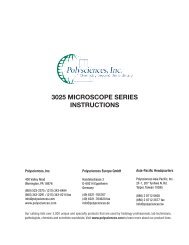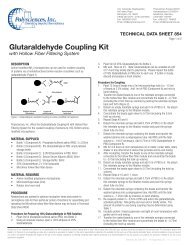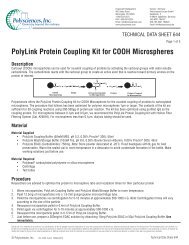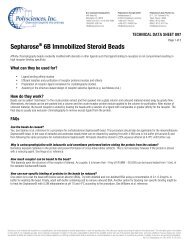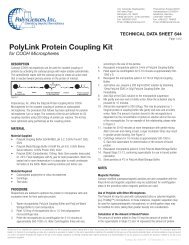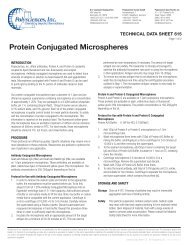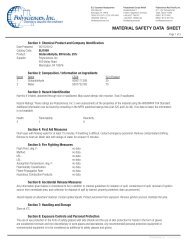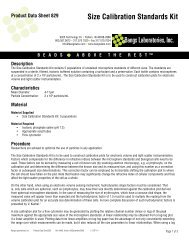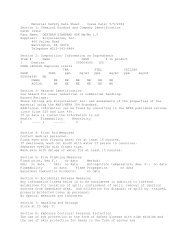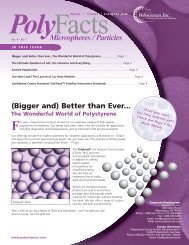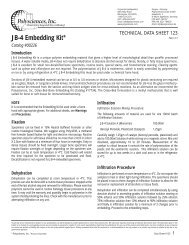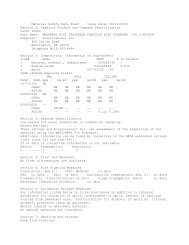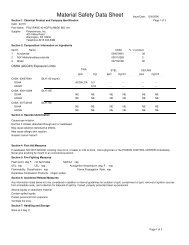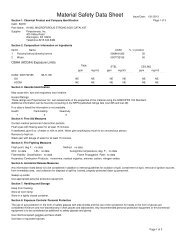Protein Coupling Reagents - Polysciences, Inc.
Protein Coupling Reagents - Polysciences, Inc.
Protein Coupling Reagents - Polysciences, Inc.
You also want an ePaper? Increase the reach of your titles
YUMPU automatically turns print PDFs into web optimized ePapers that Google loves.
Corporate Headquarters<br />
400 Valley Road<br />
Warrington, PA 18976<br />
1-800-523-2575<br />
FAX 1-800-343-3291<br />
Email: info@polysciences.com<br />
www.polysciences.com<br />
Europe - Germany<br />
<strong>Polysciences</strong> Europe GmbH<br />
Handelsstr. 3<br />
D-69214 Eppelheim, Germany<br />
(49) 6221-765767<br />
FAX (49) 6221-764620<br />
Email: info@polysciences.de<br />
<strong>Protein</strong> <strong>Coupling</strong> <strong>Reagents</strong><br />
Technical Data Sheet 410<br />
Page 1 of 2<br />
Description<br />
The concept of binding globulin to polystyrene latex developed by Singer and Plotz 1 has led to the use of these microspheres in<br />
agglutination tests for diagnostic purposes. When antibody - coated microparticles are mixed with a solution of the specific antigen,<br />
the microparticles will agglutinate. Similarly, antigen - coated microparticles will agglutinate in the presence of the corresponding<br />
antibody. Detection of agglutination can be accomplished by visual inspection, which is facilitated by dyed particles. Detection can also<br />
be accomplished with the use of various instrumental measurements, such as turbidimetric and nephelometric measurements, angular<br />
dissymmetry, quasi - elastic light scattering and particle counting. 2<br />
The simplest method of attaching proteins to microparticles is by passive adsorption. Passive adsorption is adequate for most short<br />
- term applications, but the adsorbed proteins may gradually desorb. However, some passively adsorbed proteins have been reported to<br />
be stable for at least two months. 3<br />
<strong>Inc</strong>rease Shelf Life by Covalent <strong>Coupling</strong><br />
Various methods have been developed for the covalent linking of proteins to microspheres via functional groups on the surface of the<br />
microspheres. 4, 5 In these methods, the functional groups on the surface of the beads are activated prior to the coupling of proteins.<br />
For example, carboxylated groups are activated by using a carbodiimide derivative 6 and amino groups are activated by glutaraldehyde. 7,<br />
8<br />
Once proteins are covalently attached to microparticles, desorption is minimal even after two years if the coupled microparticles are<br />
stored at 4˚C in the presence of a preservative like sodium azide.<br />
Match <strong>Reagents</strong> and Beads from One Source<br />
<strong>Polysciences</strong> can serve as the complete source of reagents needed for coupling proteins to microparticles. Protocols for passive<br />
adsorption of proteins to polystyrene beads (Technical Data Sheet #238E), covalent coupling of proteins to carboxylated beads<br />
(Technical Data Sheet #238C) and covalent coupling of proteins to blue dyed and amino functionalized beads (Technical Data Sheet<br />
#238D) are available upon request. In addition, we offer two kits for covalently attaching proteins to microparticles. One kit contains<br />
buffers and other reagents for coupling proteins to carboxylated beads (Cat. # 24350), while the other kit contains buffers and other<br />
reagents for coupling proteins to blue dyed and amino functionalized beads (Cat. # 19540). The contents of each kit are sufficient for<br />
coupling proteins to at least fifty 0.5ml samples (2.5% solids) of beads. A detailed instruction sheet is enclosed with each kit. These<br />
instruction sheets are also available upon request (Technical Data Sheet #644 - Instruction Sheet for Cat. # 24350; Technical Data Sheet<br />
#238G - Instruction Sheet for Cat. #19540) or by visiting our website at www.polysciences.com.<br />
Immunobeads - Precoupled with <strong>Protein</strong>s<br />
<strong>Polysciences</strong> also offers immunobeads and magnetic immunobeads for research purposes. The immunobeads are carboxylated<br />
polystyrene beads, fluorescent carboxylated polystyrene beads and blue dyed polystyrene beads of 1µm diameter covalently coupled<br />
with protein A and antibodies. The magnetic immunobeads are called Colloidal Magnetite Particles (50nm diameter) and Micro Magnetite<br />
Particles (1µm diameter) covalently coupled with protein A and antibodies. For a complete list of immunobeads, magnetic immunobeads<br />
and other microspheres, write for Technical Data Sheet #238, download the Technical Data Sheet from our website or see our current<br />
catalog. Agglutination slide tests and immunofluorescence slides are also available from <strong>Polysciences</strong>. We can also couple proteins or<br />
microspheres of your choice on a custom basis. Write or call us for quotes.<br />
References<br />
1. Singer, J.M., R.M. Plotz. 1971. Am J Med, 31: 766.<br />
2. Looney, C.J. 1984. Immunoassay, 7(1).<br />
Should any of our materials fail to perform to our specifications, we will be pleased to provide replacements or return the purchase price. We solicit your inquiries concerning all needs for life sciences work. The information given in this bulletin is to<br />
the best of our knowledge accurate, but no warranty is expressed or implied. It is the user’s responsibility to determine the suitability for their own use of the products described herein, and since conditions of use are beyond our control, we disclaim all<br />
liability with respect to the use of any material supplied by us. Nothing contained herein shall be construed as a recommendation to use any product or to practice any process in violation of any law or any government regulation.<br />
© <strong>Polysciences</strong>, <strong>Inc</strong>. Rev. #002, Active: 28/August/2007<br />
Technical Data Sheet 410
Technical Data Sheet 410<br />
Page 2 of 2<br />
3. Von Schulthess, C., et al. 1982. U.S. Patent No. 4,350,677.<br />
4. Masson, P.L., et al. in Methods in enzymology (J.T. Langone, ed.).<br />
5. Bangs, L.B. 1987. Am Biotech Lab, May/June: 10.<br />
6. Daniel, J.C. 1977. U.S. Patent No. 4,064,080.<br />
7. Galvin, J.P. 1983. Diag Immunology Assessment (C.A.P.).<br />
8. Goodfriend, T.L., et al. 1964. Science, 144: 1344.<br />
This product is for research use only and is not intended for use in humans or for in vitro diagnostic use.<br />
Ordering Information<br />
Cat. # Description Size<br />
24350 PolyLink <strong>Protein</strong> <strong>Coupling</strong> Kit for COOH Microspheres 1 kit<br />
24818 PolyLink <strong>Protein</strong> <strong>Coupling</strong> Kit with Hollow Fiber Filtering System 1 kit<br />
19540 Glutaraldehyde Kit for Amino and Blue Dyed beads 1 kit<br />
23964 Glutaraldehyde Kit with Hollow Fiber Filtering System 1 kit<br />
18208 Agglutination Test Slides (2 x 4.25”) box of 50<br />
00006 Boric Acid 2kg<br />
00455 N,N’-Dicyclohexylcarbodiimide 100g<br />
05288 1-Ethyl-3(3-dimethylaminopropyl)-carbodiimide hydrochloride (EDC) 5g or 25g<br />
01909 Glutaraldehyde, 25% EM Grade 100ml amp (10 x 10ml)<br />
00084 Glycerol, U.S.P. 1kg<br />
18357 Immunofluorescence slides Box of 100<br />
(25 x 75mm, one end frosted; 10 x 6mm dia. wells)<br />
00398 Sodium phosphate, dibasic 500g<br />
00400 Sodium phosphate, monobasic 500g<br />
To Order<br />
In The U.S. Call: 1-800-523-2575 • 215-343-6484<br />
In The U.S. FAX: 1-800-343-3291 • 215-343-0214<br />
In Germany Call: (49) 6221-765767<br />
In Germany FAX: (49) 6221-764620<br />
Order online anytime at www.polysciences.com.<br />
Should any of our materials fail to perform to our specifications, we will be pleased to provide replacements or return the purchase price. We solicit your inquiries concerning all needs for life sciences work. The information<br />
given in this bulletin is to the best of our knowledge accurate, but no warranty is expressed or implied. It is the user’s responsibility to determine the suitability for their own use of the products described herein, and since<br />
conditions of use are beyond our control, we disclaim all liability with respect to the use of any material supplied by us. Nothing contained herein shall be construed as a recommendation to use any product or to practice<br />
any process in violation of any law or any government regulation.<br />
© <strong>Polysciences</strong>, <strong>Inc</strong>. Rev. #002, Active: 28/August/2007 Technical Data Sheet 410



